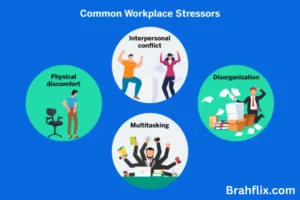Introduction
In today’s fast-paced work environment, stress has become a common challenge that can adversely affect productivity, mental health, and overall job satisfaction. According to the American Psychological Association (APA), approximately 61% of employees report feeling stressed at work, which can lead to burnout and decreased performance. This highlights the importance of adopting effective strategies to manage stress effectively.
In this article, we will explore 5 ways to manage stress in the workplace, offering practical solutions that can help create a more balanced and fulfilling work experience. By implementing these strategies, individuals and organizations can foster a healthier work environment conducive to productivity and employee well-being.
Key Takeaways
- 61% of employees experience stress at work.
- Effective stress management can enhance productivity and job satisfaction.
- Simple changes in daily routines can significantly impact overall well-being.
1. Foster a Supportive Work Environment
Creating a supportive work environment is crucial for managing stress effectively. Employees who feel valued and supported are more likely to thrive and contribute positively to their organizations.
Benefits of a Supportive Environment
- Increased Job Satisfaction: Employees are happier and more engaged when they feel supported.
- Enhanced Collaboration: A supportive culture encourages teamwork and open communication.
- Reduced Turnover Rates: Employees are less likely to leave an organization that prioritizes their well-being.
How to Foster Support
- Open Communication: Encourage transparency by promoting regular feedback sessions. This helps employees voice concerns and feel heard.
- Team Building Activities: Organize regular team-building exercises that promote camaraderie and strengthen relationships among colleagues.
- Flexible Work Arrangements: Allow for remote work or flexible hours to help employees balance their personal and professional lives.
Research Insight: A study by Gallup found that employees who feel supported by their managers are 70% more likely to be engaged at work.
2. Encourage Regular Breaks
Taking regular breaks throughout the workday can significantly reduce stress levels and improve overall productivity. Continuous work without breaks can lead to fatigue and burnout.
The Importance of Breaks
- Improved Focus: Short breaks help refresh the mind, enhancing concentration and efficiency.
- Reduced Stress: Stepping away from tasks allows employees to recharge, minimizing feelings of overwhelm.
- Enhanced Creativity: Breaks can foster creativity, as a change of scenery often leads to new ideas.
Tips for Incorporating Breaks
- Schedule Breaks: Encourage employees to schedule regular breaks throughout the day, ideally every 90 minutes.
- Encourage Movement: Promote physical activity during breaks, such as short walks or stretching exercises.
- Mindfulness Practices: Integrate mindfulness techniques, such as meditation or deep-breathing exercises, to help employees relax during breaks.
Statistics Show: The University of Illinois found that taking short breaks can improve focus by up to 25%.
3. Promote Work-Life Balance
Achieving a healthy work-life balance is essential for reducing stress and enhancing overall well-being. When employees can manage their professional and personal lives effectively, they are more likely to experience lower stress levels.
Strategies for Promoting Work-Life Balance
- Set Clear Boundaries: Encourage employees to establish boundaries between work and personal time, especially in remote work settings.
- Time Management Training: Provide workshops on time management skills to help employees prioritize tasks effectively.
- Encourage Time Off: Promote the use of vacation days and personal time to help employees recharge.
Quote: “You can’t pour from an empty cup. Take care of yourself first.” — Unknown. Prioritizing personal time is essential for maintaining energy and motivation.
The Benefits of Work-Life Balance
- Increased Productivity: Employees with a balanced lifestyle tend to be more productive and engaged at work.
- Reduced Stress Levels: A good balance minimizes the risk of burnout and promotes mental health.
- Improved Employee Retention: Companies that support work-life balance often see lower turnover rates.
4. Provide Stress Management Resources
Equipping employees with stress management resources can significantly enhance their ability to cope with workplace pressures. Organizations can provide various tools and programs to help employees manage stress effectively.
Types of Resources to Offer
- Employee Assistance Programs (EAPs): These programs provide access to counseling services and mental health resources, allowing employees to seek help confidentially.
- Wellness Programs: Implementing wellness initiatives, such as yoga classes or stress-relief workshops, can promote physical and mental health.
- Online Resources: Offer access to online courses or articles on stress management techniques, mindfulness practices, and healthy coping strategies.
Fact: A survey by the Society for Human Resource Management (SHRM) indicates that organizations offering wellness programs see a 28% increase in employee satisfaction.
5. Encourage Professional Development
Supporting professional development can help employees feel more competent and confident in their roles, which can, in turn, reduce stress levels. When employees have opportunities to learn and grow, they are more likely to be engaged and satisfied with their work.
Ways to Promote Professional Development
- Training Opportunities: Provide access to training sessions, workshops, and conferences to help employees develop new skills.
- Mentorship Programs: Establish mentorship programs that connect less experienced employees with seasoned professionals for guidance and support.
- Career Advancement Paths: Clearly outline career paths and opportunities for advancement within the organization, encouraging employees to pursue their professional goals.
Data Insight: According to a report by LinkedIn, 94% of employees stated they would stay at a company longer if it invested in their career development.
Frequently Asked Questions (FAQs)
1. How can I identify signs of stress in the workplace?
Common signs include decreased productivity, irritability, increased absenteeism, and difficulty concentrating.
2. What are some quick stress relief techniques I can use at work?
Deep breathing exercises, stretching, and taking a short walk can all provide immediate stress relief.
3. How important is communication in managing workplace stress?
Open communication is crucial; it fosters a supportive environment where employees feel comfortable discussing their challenges.
4. What role does management play in stress management?
Management should lead by example, promoting healthy practices and providing resources to support employee well-being.
5. Can workplace stress affect physical health?
Yes, chronic stress can lead to various health issues, including cardiovascular disease, obesity, and weakened immune response.
Conclusion
Managing stress in the workplace is essential for fostering a healthier, more productive work environment. By implementing the 5 ways to manage stress in the workplace discussed in this article, organizations can significantly improve employee well-being and overall job satisfaction.
How have you managed stress in your workplace? We encourage you to explore our other blogs for more insights and practical tips on enhancing workplace culture and employee health. Together, we can create a more supportive and engaging work environment!